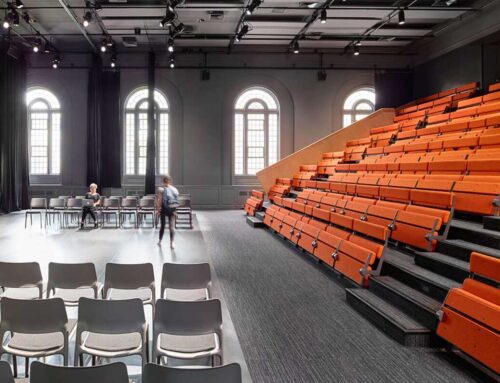Exploring The Benefits of Athletic Flooring
Quality in athletic flooring is not just a buzzword – it’s the difference between a long-lasting floor and one that just doesn’t hold up. It’s the difference between tiring out your athletes and giving them a boost. It’s the difference between more injuries and less injuries. Quality is most important for our athletes, but it also makes financial sense. Quality means the difference between a floor that can last a few years and one that can last for decades. Quality starts with engineering – you can’t deliver quality unless you understand the science of what makes the best performance floor. What materials are used, where they are sourced, how the floor is manufactured, and most importantly, the quality of the installer are all factors in what makes a quality athletic floor. Those factors will determine how well the floor serves your athletes and also determine how long your floor will last.
 What Is Sports Flooring?
What Is Sports Flooring?
Sports flooring, in general, is any floor that is designed with resiliency in mind – the ability for recovery from impact, whether from a ball or from an athlete. Sports flooring is a term that refers to the type of flooring that has qualities sufficient to enhance and support the athletes in their sport. As anyone who has played any sport knows, the quality of the surface on which you are playing can make a huge difference. Ask anyone who trains on grass and then is asked to train on concrete. After hours of rigorous activity, the human body will readily show signs of fatigue on a concrete floor that it will not on grass. Every athlete and coach knows this concept. It’s easy to understand when we’re talking about grass versus concrete, but the same principles apply regardless of the flooring types you are considering. Each sports floor has characteristics that can either enhance or detract from your athlete’s performance, and it’s important to have a contractor who understands this.
The Benefits of Athletic Flooring For Athletes
1. Shock Absorption
One of the most important factors in racking up wins for any athlete or any team is injury prevention and reduction. That’s why before we learn any sport, we are taught to stretch. Similarly, we need to make sure our floor can stretch with us – and reduce the amount and severity of both repetitive and acute impact stress on the body. Shock absorption is the key flooring component helping us to achieve this goal. By absorbing shock, sports floors allow for faster and stronger recoveries from repetitive impacts, however minor. As children, we all learn the difference between falling on cement and falling in the dirt. True, both hurt, but we all instinctively know how much worse one is than the other.
2. Improved Safety
 Safety is paramount in every sport. For some sports it’s not the surface. Football, hockey, and rugby players wear equipment to protect them from the impact of other players. Baseball players similarly need helmets to protect themselves from a fast ball. But there are certain sports where the surface is the most important aspect. Soccer requires an even grass surface free of divots and holes. Tennis surfaces need to be free of cracks and divots. Basketball courts must be uniform in their performance, free of dead spots.
Safety is paramount in every sport. For some sports it’s not the surface. Football, hockey, and rugby players wear equipment to protect them from the impact of other players. Baseball players similarly need helmets to protect themselves from a fast ball. But there are certain sports where the surface is the most important aspect. Soccer requires an even grass surface free of divots and holes. Tennis surfaces need to be free of cracks and divots. Basketball courts must be uniform in their performance, free of dead spots.
Science tells us that the most important factor in determining the safety of any performance flooring is the consistency of the play on its surface. For example, if a high-performing, high shock-absorbing floor was installed for a basketball court, but the concrete was not corrected prior to installation, there will be dead spots in the floor. No amount of resiliency in that floor can overcome the negative impact of the inconsistent playing surface. The athletes, whether they know it or not, will experience more fatigue and injury through those dead spots than they would if the floor was consistent, but had no resilience. Studies have proved this concept many times with many different floors. Whether it’s high school basketball or seniors playing pickleball, if playing on an inconsistent surface will see increased fatigue and injury over time.
3. Durability and Longevity
Athletes need a surface that provides them with longevity in the sport. Similarly, facility directors need a floor that will provide a different, but just as important type of longevity. Quality materials used in a system with superior engineering will always last longer than floors which lack either. Shoddy materials can degrade quickly, causing the flooring surface to perform in an inconsistent way, which as we have already said, is not good. Dead spots, hard or soft spots can be created through the wear on materials that are not up to the task. Similarly, the design and construction of any gym floor has to have these principles in mind to make sure that the construction is solid. For example, if a wood basketball court is properly constructed with quality materials, with annual maintenance, the floor could last 30 years or more! But a rubber floor for the same type, while cheaper, might need to be replaced 8-10 times during that same time frame.
Factors to Consider When Selecting Sports Flooring
 1. Impact Absorption and Shock Resistance
1. Impact Absorption and Shock Resistance
There are several factors that are important when considering which sports floor is right for you. It’s important to know how much shock absorption you want. For example, in dance and martial arts and gymnastics more shock absorption and resilience are generally preferred. For sports like pickleball and indoor soccer and tennis, generally speaking less shock absorption is preferred. Sports like basketball tend to fall in the middle of this range, but even with that, there are many variations.
2. Surface Texture and Traction
Surface texture is another important factor when choosing a sports floor. The type of finish used on a wood floor can change entirely the way that floor feels and performs. Using a synthetic or rubber floor also allows for a choice of many different surface textures. Some facilities are specific to one sport, and the need to choose the right texture is crucial. Other facilities are multipurpose, and a balance needs to be struck. For example, a high school that uses a synthetic surface for many sports would likely choose a flat textured surface to ensure that all sports (volleyball, basketball, pickleball, etc.) can be played on the same non-slip surface. Conversely, when constructing a new tennis court, surface friction will ultimately determine the speed of play for the tennis ball. Tennis courts are classified using texture (ball speed), so that athletes can know in advance which surface they are playing on.
3. Durability and Maintenance
 Durability and maintenance are always a concern when selecting a sports floor. Most sports floors are designed to last a decade at least. Proper maintenance is required to get the longest life out of any floor, but especially with performance floors. Floors that are designed to move – anything that is designed to move – requires an attention to maintenance that a non-resilient floor does not. At a bare minimum, any sports floor should receive annual maintenance – and depending on the use, it could be more than annually. The more care that is paid to maintenance will ultimately determine how long the floor lasts and performs as intended. For example: floors installed at Boston College look the same today as they did when they were installed over 5 years ago because they follow proper maintenance guidelines. Conversely, a similar floor constructed in NYC at the same time had to be resanded twice in that same time. They were the same quality of materials and installation, but as always with sports floors, maintenance made all the difference. In the end, Boston will spend far less on their floor than the other school because of their attention to maintenance.
Durability and maintenance are always a concern when selecting a sports floor. Most sports floors are designed to last a decade at least. Proper maintenance is required to get the longest life out of any floor, but especially with performance floors. Floors that are designed to move – anything that is designed to move – requires an attention to maintenance that a non-resilient floor does not. At a bare minimum, any sports floor should receive annual maintenance – and depending on the use, it could be more than annually. The more care that is paid to maintenance will ultimately determine how long the floor lasts and performs as intended. For example: floors installed at Boston College look the same today as they did when they were installed over 5 years ago because they follow proper maintenance guidelines. Conversely, a similar floor constructed in NYC at the same time had to be resanded twice in that same time. They were the same quality of materials and installation, but as always with sports floors, maintenance made all the difference. In the end, Boston will spend far less on their floor than the other school because of their attention to maintenance.
4. Environmental Considerations
In today’s world, the environment is always a consideration when talking about building materials. Not only are a wide range of eco-friendly and sustainable products available, but all of the sports flooring products used are also tested for their compliance with indoor air quality standards. The wood sports flooring industry has planted more trees each year than it cuts down – and it has been doing this for decades. Similarly, the finish applied to wood floors is more eco-friendly than ever before – reducing the use of Volatile Organic Compounds (VOCs) dramatically in the last 20 years. Sports flooring continues to offer environmentally friendly options for our planet and our players.
5. Budget and Long-term Investment
Commonly, cost is the most important factor when choosing a sports floor. A word of advice about cost: when selecting a sports floor, ask for the annual maintenance cost as well as the expected life expectancy of the floor. This calculation is invaluable when cost is the determinative factor. Spending a little more now can save you tens or hundreds of thousands. Return on investment and life-cycle costs of a sports floor prove time and again that quality matters. By recoating a basketball court at least once per year and refinishing it every ten years, a traditional wood basketball court can last 30-50 years. There is no vinyl floor that can claim the same duration. While cheaper and easier to install, over the same time frame using vinyl a school might have to replace the floor 8-10 times.
Athletic Flooring Installation Made Easy With Endurance Flooring
Endurance Flooring offers a wide range of athletic flooring options to ensure safety, performance, and longevity. Endurance can meet the unique needs of any sports facility or venue. Endurance uses superior installation teams backed by decades of expertise and people who understand the science. Our name, Endurance, comes from a definition of the word “Sustainability” – “The Capacity to Endure…” We want to build a sustainable, predictable future for your athletic facility. In short, we take pride in our corporate motto: floors engineered, manufactured, and installed with the capacity to endure.



Leave A Comment